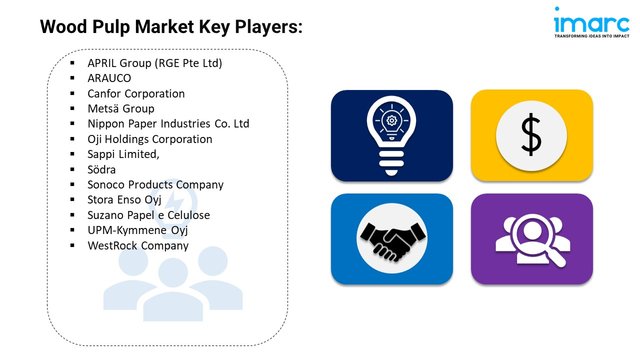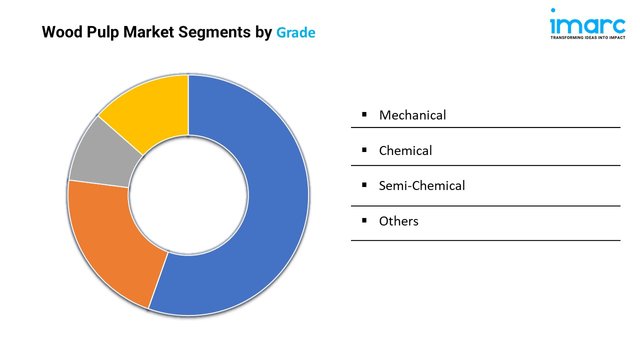Wood Pulp Market to Hit $223.87B by 2033: Trends & Opportunities Unveiled
Market Overview:
The wood pulp market is experiencing rapid growth, driven by sustainable sourcing pressure, packaging & tissue demand, and technological & innovation shifts. According to IMARC Group’s latest research publication, “Wood Pulp Market Size, Share, Trends and Forecast by Type, Grade, End Use Industry, and Region 2025-2033“, The global wood pulp market size was valued at USD 174.30 Billion in 2024. Looking forward, IMARC Group estimates the market to reach USD 223.87 Billion by 2033, exhibiting a CAGR of 2.68% during 2025-2033.
This detailed analysis primarily encompasses industry size, business trends, market share, key growth factors, and regional forecasts. The report offers a comprehensive overview and integrates research findings, market assessments, and data from different sources. It also includes pivotal market dynamics like drivers and challenges, while also highlighting growth opportunities, financial insights, technological improvements, emerging trends, and innovations. Besides this, the report provides regional market evaluation, along with a competitive landscape analysis.
Grab a sample PDF of this report: https://www.imarcgroup.com/wood-pulp-market/requestsample
Our report includes:
- Market Dynamics
- Market Trends And Market Outlook
- Competitive Analysis
- Industry Segmentation
- Strategic Recommendations
Factors Affecting the Growth of the Wood Pulp Industry:
- Sustainable Sourcing Pressure:
The wood pulp market faces pressure to adopt permanent sourcing practices. Growing environmental awareness and stricter regulations drive this shift. Consumers and industries want transparency and traceability throughout the supply chain. Manufacturers must consider certifications like FSC (Forest Stewardship Council) and PEFC (Program for the Endorsement of Forest Certification). There’s also a trend towards circular economy principles. These principles promote using recycled fibers and creating closed-loop production systems. Companies are responding to customer demands to reduce deforestation and protect biodiversity. They are investing in sustainable forest management practices, including forestry initiatives and redistribution efforts. Organizations committed to sustainable procurement gain a competitive edge. They attract more environmentally conscious consumers and ensure long-term access to raw materials. Showing a transparent commitment to stability helps protect market share and supports the woodland mass movement now and in the future. This issue will likely grow in importance over the forecast period.
-
Packaging & Tissue Demand:
A key market driving steady wood pulp demand is packaging and tissue. E-commerce growth and the need for permanent packaging boost the use of wood-based materials. Cardboard and containerboard made from wood pulp are durable due to their biodegradability and recyclability. The tissue sector also has three main consumers: tissue paper and wipes. New developments often increase demand among these consumers. The rising middle class in emerging economies adds to the demand for these wood products. Additionally, dedicated mass-based materials made from wood, like biobased packaging and specialty applications, expand market uses. As consumers and companies seek alternatives to plastic packaging, wood pulp is set to play a key role in providing durable, eco-friendly solutions. This rising demand in packaging and tissue will drive increased consumption of wood.
-
Technological & Innovation Shifts:
The wood products industry is seeing many changes due to technology and innovation. These changes will boost market efficiency, reduce environmental impact, and enhance product quality. Producers using green and yellow technologies can lower energy and water use while cutting down on chemicals. The shift toward bioprocessing offers new chances to create biochemicals and valuable fuel alternatives from wood pulp. Digital technologies are also helping optimize production. They automate tasks and analyze data on processes, material flow, and quality control. New tire products designed for specific applications are driving innovation. This includes high-strength materials for packaging and ultralight materials for wipes. Combining nanotechnology with advanced material science enables the creation of new wood-based products with improved properties. These technical changes will strengthen competition in the wood products industry and reduce the need for market disruptions. Continuous innovation is essential for the industry to stay competitive.
Leading Companies Operating in the Global Wood Pulp Industry:
- APRIL Group (RGE Pte Ltd)
- ARAUCO
- Canfor Corporation
- Mets Group
- Nippon Paper Industries Co. Ltd
- Oji Holdings Corporation
- Sappi Limited,
- Sdra
- Sonoco Products Company
- Stora Enso Oyj
- Suzano Papel e Celulose
- UPM-Kymmene Oyj
- WestRock Company
Wood Pulp Market Report Segmentation:
Breakup By Type:
- Hardwood
- Softwood
Hardwood accounts for the majority of shares as it is more durable and has higher density as compared to softwoods
Breakup By Grade:
- Mechanical
- Chemical
- Semi-Chemical
- Others
Mechanical dominates the market on account of the rising need for magazines and newsprints.
Breakup By End Use Industry:
- Packaging
- Food and Beverages
- Pharmaceutical
- Personal Care and Cosmetics
- Automotive
- Others
- Paper
- Newspaper
- Books and Magazines
- Tissues
- Others
- Others
Packaging represents the majority of shares due to the thriving food and beverage (F&B) industry.
Breakup By Region:
- North America (United States, Canada)
- Asia Pacific (China, Japan, India, South Korea, Australia, Indonesia, Others)
- Europe (Germany, France, United Kingdom, Italy, Spain, Russia, Others)
- Latin America (Brazil, Mexico, Others)
- Middle East and Africa
Asia Pacific enjoys the leading position owing to a large market for wood pulp driven by the increasing need for eco-friendly packaging solutions to mitigate carbon footprint.
Research Methodology:
The report employs a comprehensive research methodology, combining primary and secondary data sources to validate findings. It includes market assessments, surveys, expert opinions, and data triangulation techniques to ensure accuracy and reliability.
Note: If you require specific details, data, or insights that are not currently included in the scope of this report, we are happy to accommodate your request. As part of our customization service, we will gather and provide the additional information you need, tailored to your specific requirements. Please let us know your exact needs, and we will ensure the report is updated accordingly to meet your expectations.
About Us:
IMARC Group is a global management consulting firm that helps the world’s most ambitious changemakers to create a lasting impact. The company provide a comprehensive suite of market entry and expansion services. IMARC offerings include thorough market assessment, feasibility studies, company incorporation assistance, factory setup support, regulatory approvals and licensing navigation, branding, marketing and sales strategies, competitive landscape and benchmarking analyses, pricing and cost research, and procurement research.
Contact Us:
IMARC Group
134 N 4th St. Brooklyn, NY 11249, USA
Email: sales@imarcgroup.com
Tel No:(D) +91 120 433 0800
United States: +1-631-791-1145

